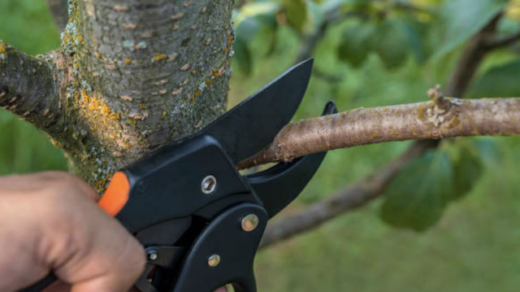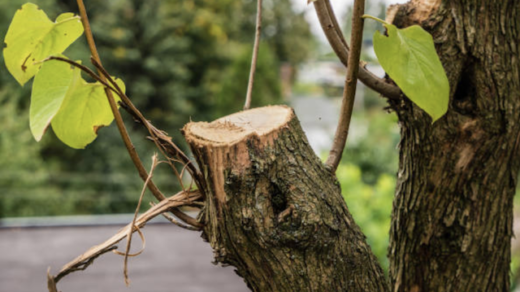Trees are living things, so that means that they can become “sick” like people and animals can. A disease or other tree problem may take a little while to show appear due to the sheer size of the tree, and once symptoms become clear, it could be too late to save the tree.
A certified arborist from AK Tree Trimming can diagnose and treat tree problems so that you have a much better chance of saving the tree. Learn about our service here. Not only can an arborist prevent a tree from dying, but they are also able to help trees get healthier growth and more flowers or fruit with professional tree trimming.
Have you noticed a tree on your property that has always seemed healthy but suddenly seems like something is wrong? In the next paragraphs, we’ll describe some of the most common tree problems and what these symptoms mean.
If you spot any of these things on any of your trees, act fast for the best chance of saving the tree and the ones nearby it.
Tree Diseases & Common Problems
These 7 things are the most common issues addressed by professional arborists in Alaska. The moment you think one of these things is wrong with your tree, contact someone with the knowledge and equipment to help!
Tree Diseases
Leaf Rust – Leaf rust is a fungus that is common in both trees and plants. The name comes from the brown and yellow spots this disease produces on the leaves.
Leaf rust is bad because it inhibits the leaves’ photosynthesis, the process by which it breathes. Leaf rust can be treated with fungicides and selective tree trimming of the diseased leaves. It could be necessary to remove entire branches with leaf rust.
Witches’ Broom – This common tree disease results in a large clump of twigs, dead leaves and branches that resemble a broom shape. It is caused by pests, unusually rainy weather or fungus. The formation of a clump of leaves and twigs is the tree’s reaction to infection or danger.
Some instances of Witches’ Broom are deadly for the tree, while others are just considered a growth malformation. An arborist can diagnose the issue.
Mildew – Mildew is a fungus that grows on almost anything in moist conditions, but even after the wet conditions are gone, mildew can persist and thrive. It appears as a powdery substance, usually white, and it often grows on the leaves of the tree first.
The trick to treating mildew is to use a fungicide that contains sulfur. This will remove the current mildew and help to prevent future mildew on the tree. You may also need to trim the tree to remove branches, fruit, flowers and any leaves that have been affected by the mildew
Gall – Gall is a type of tree disease that occurs when pests or rodents build small nests on the leaves or twigs of a tree to leave their eggs in. Most types of galls are not harmful to the tree, but none of them are attractive.
Gall will appear as bumps on the tree, in varying sizes. They are often white, brown, gray or some color in between.
You do not have to treat the tree for galls, but they can affect the growth of recently planted trees. Treat galls by killing the insects. You should also clean out from under the tree after the leaves fall off, because this is where the insects live during winter months.
Other Tree Problems
Poor Pruning – There’s an art to tree pruning, as well as many types, and if you aren’t sure how to do it, you could damage the tree beyond recovery. Consider the type of tree, season and other factors. Under-pruning (or not pruning at all) is just as big of an issue. Only a trained arborist should be trusted to trim trees in order to keep them healthy.
Lack of Water – Young trees can be severely impacted by drought. If you plant new trees on your property, you will probably have to supplement how much water they get from rainfall. A tree that is not getting enough water will have its growth stunted. The first symptom you are likely to noticed is scorched, dry leaves. Find more tips for new trees here.
Too Much Sun – Do some planning before planting trees in a sunny area. Many types of trees can handle it just fine, but too much sun can happen to any tree if the sun is too hot for an extended period of time and rainfall is light. A tree that is getting excessive sun needs even more water to fight against wilting, drooping leaves.
Certified Arborist Services in Alaska
An experienced arborist from AK Tree Trimming will be able to quickly identify what’s going on with your sick tree and put together a plan to rescue it if at all possible.
Here are the things an arborist is trained to do:
- Inspect trees from below and from the branches of the tree if possible. Climbing into the canopy is usually necessary to identify exactly what is causing the symptoms.
- Treat your tree with additives and fertilizers in the dirt or products applied to the leaves. The arborist will have expert knowledge about the disease affecting your tree and the best treatments for it.
- Trim tree limbs to eliminate dead or diseased branches and to assist healthy growth. Even if heavy trimming is needed, they will know how to cut off branches so that the tree survives both the problem and the trimming.
- Remove the tree from your lawn if there is no chance to save it. The worst case is that the tree is dying, and removing it is the only choice to protect your home and surrounding landscape.
They can also educate you about the trees that you have om your property and how to best maintain them so you don’t find yourself in the same situation again.
Many tree issues look very similar to each other, requiring a professional opinion to correctly determine and treat the issue. If your trees appear to be dry, unhealthy or disfigured, call a certified arborist from AK Tree Trimming for an inspection before it’s too late for your tree.






